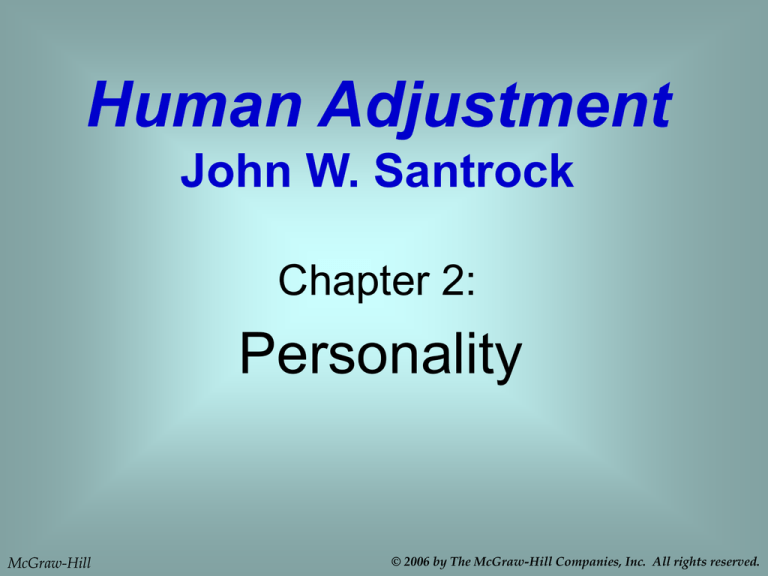
Human Adjustment
John W. Santrock
Chapter 2:
Personality
McGraw-Hill
© 2006 by The McGraw-Hill Companies, Inc. All rights reserved.
2-2
What Is Personality?
Personality = pattern of enduring and distinctive
thoughts, emotions, and behaviors that characterize
how an individual adapts to the world
Theoretical perspectives on personality:
– psychodynamic
– behavioral and social cognitive
– humanistic
– trait
McGraw-Hill
©2006 by the McGraw-Hill Companies, Inc. All rights reserved.
2-3
What Is Personality?
Four important questions about personality:
– What role do innate and learned characteristics play in
personality?
– To what extent is personality conscious or unconscious?
– How influential are internal or external factors in determining
personality?
– What characterizes a well-adjusted personality?
McGraw-Hill
©2006 by the McGraw-Hill Companies, Inc. All rights reserved.
2-4
Freud's Psychoanalytic Theory
Psychodynamic Perspectives - view personality as
being primarily unconscious and as developing in
stages
McGraw-Hill
©2006 by the McGraw-Hill Companies, Inc. All rights reserved.
2-5
Freud’s Psychoanalytic Theory
Sigmund Freud
– born in Austria in 1856 / died in England in 1939
– spent most of life in Vienna
– became medical doctor specializing in neurology
– developed psychoanalytic theory through work with
psychiatric patients
McGraw-Hill
©2006 by the McGraw-Hill Companies, Inc. All rights reserved.
2-6
Freud’s Psychoanalytic Theory
Freud believed most of the mind is unconscious
Freud’s psychoanalytic theory stated that personality
has three structures:
– id - pleasure (sexual and aggressive instincts)
– ego - reality (deals with demands of reality)
– superego - conscience (morality)
McGraw-Hill
©2006 by the McGraw-Hill Companies, Inc. All rights reserved.
2-7
Defense Mechanisms
When ego blocks pleasurable pursuits of id, person
feels anxiety
Defense mechanisms = ego’s protective
methods for reducing anxiety by unconsciously
distorting reality
McGraw-Hill
©2006 by the McGraw-Hill Companies, Inc. All rights reserved.
2-8
Defense Mechanisms
Defense mechanisms include:
–
–
–
–
–
–
–
–
McGraw-Hill
repression
rationalization
displacement
sublimation
projection
reaction formation
denial
regression
©2006 by the McGraw-Hill Companies, Inc. All rights reserved.
2-9
Freud’s Theory of Personality Development
Freud was convinced that problems develop because
of early childhood experiences
Freud proposed 5 stages of personality development:
–
–
–
–
–
McGraw-Hill
oral
anal
phallic
latency
genital
©2006 by the McGraw-Hill Companies, Inc. All rights reserved.
2-10
Freud’s Theory of Personality Development
Freud claimed that at each stage, demands of reality
conflict with source of pleasure
Adult personality depends on how person deals with
the conflict
McGraw-Hill
©2006 by the McGraw-Hill Companies, Inc. All rights reserved.
2-11
Psychodynamic Revisionists
Criticisms of Freud:
– too much emphasis on sexuality
– first 5 years are not as important
– ego and conscious thought more important
– sociocultural factors more important
McGraw-Hill
©2006 by the McGraw-Hill Companies, Inc. All rights reserved.
2-12
Horney’s Sociocultural Theory
Karen Horney (1885–1952)
– developed first feminist criticism of Freud’s theory
Need for security is most important human motive
McGraw-Hill
©2006 by the McGraw-Hill Companies, Inc. All rights reserved.
2-13
Horney’s Sociocultural Theory
People develop strategies to cope with anxiety:
– move toward people, seeking love and support
– move away from people, becoming more independent
– move against people, being competitive and domineering
The secure person uses these ways of coping in
moderation
The insecure person uses one or more strategies in
exaggerated fashion
McGraw-Hill
©2006 by the McGraw-Hill Companies, Inc. All rights reserved.
2-14
Jung’s Analytical Theory
Carl Jung (1875–1961)
– thought Freud underplayed unconscious mind
Collective unconscious - impersonal, deepest layer
of unconscious mind, shared by all human beings
Archetypes - emotionally-laden ideas and images in
collective unconscious that have meaning for all
people
McGraw-Hill
©2006 by the McGraw-Hill Companies, Inc. All rights reserved.
2-15
Adler’s Individual Psychology
Alfred Adler (1870–1937)
– People strive toward creating own goals
– Emphasis on social motivation
– Everyone strives for superiority
Compensation - individual attempts to overcome
inferiorities or weaknesses by developing own abilities
Overcompensation - individual exaggerates to
conceal a weakness
McGraw-Hill
©2006 by the McGraw-Hill Companies, Inc. All rights reserved.
Adjustment Strategies Based on
Psychodynamic Approaches
2-16
1. Think about your experiences as a child and now.
2. Recognize you have unconscious feelings, drives,
and desires.
3. Examine your thoughts, feelings, and behavior to
determine extent you are using defense mechanisms.
4. Evaluate extent to which security needs are met.
5. Examine feelings of superiority or inferiority and
discover areas of life in which you can excel.
McGraw-Hill
©2006 by the McGraw-Hill Companies, Inc. All rights reserved.
2-17
Evaluating Psychodynamic Perspectives
Psychodynamic perspectives:
– view personality as primarily unconscious
– stress that personality develops in stages
– emphasize the role of the individual’s past experiences
– emphasize mental representation and transformation of
experience
– emphasize the influence of conflict on personality
McGraw-Hill
©2006 by the McGraw-Hill Companies, Inc. All rights reserved.
2-18
Classical Conditioning
Classical conditioning = learning process in
which a neutral stimulus becomes associated with
meaningful stimulus and acquires capacity to elicit a
response similar to response to meaningful stimulus
McGraw-Hill
©2006 by the McGraw-Hill Companies, Inc. All rights reserved.
2-19
Classical Conditioning
Russian physiologist Ivan Pavlov (1906) argued
classical conditioning consists of:
– conditioned stimulus
– conditioned response
Learning (Conditioning) Paradigm
– Neutral + UCR UCR
– CS
CR
Classical conditioning has been applied to
understanding fear
McGraw-Hill
©2006 by the McGraw-Hill Companies, Inc. All rights reserved.
Figure 2.6 Classical Conditioning: Boss’s
Criticism and High Blood Pressure
2-20
McGraw-Hill
©2006 by the McGraw-Hill Companies, Inc. All rights reserved.
2-21
Skinner’s Behaviorism
B. F. Skinner (1938–1990) argued that our actions on
the environment have consequences that shape our
behavior
Operant conditioning = learning process that occurs
when consequences of the behavior change the
probability of the behavior’s occurrence
McGraw-Hill
©2006 by the McGraw-Hill Companies, Inc. All rights reserved.
2-22
Reinforcement and Extinction
Reinforcement = process by which a stimulus or event
that follows a behavior increases probability that the
behavior will occur again
Positive reinforcement - frequency of behavior
increases because it is followed by rewarding stimulus
Negative reinforcement - frequency of behavior
increases because it is followed by removal of an
aversive stimulus
McGraw-Hill
©2006 by the McGraw-Hill Companies, Inc. All rights reserved.
2-23
Reinforcement and Extinction
Extinction - frequency of a previously reinforced
behavior that is no longer reinforced decreases
McGraw-Hill
©2006 by the McGraw-Hill Companies, Inc. All rights reserved.
2-24
Punishment
Punishment decreases likelihood that a behavior
will occur
Positive punishment - behavior
decreases when followed by
unpleasant stimulus
Negative punishment - behavior
decreases when positive stimulus
is removed
McGraw-Hill
©2006 by the McGraw-Hill Companies, Inc. All rights reserved.
2-25
Positive and Negative Reinforcement, Positive
and Negative Punishment
McGraw-Hill
©2006 by the McGraw-Hill Companies, Inc. All rights reserved.
2-26
Applying Skinner’s Approach to Personality
Skinner’s behaviorism emphasizes that cognition is
unimportant in personality
Personality is observable behavior, which is influenced
by rewards and punishments in the environment
In the behavioral view, personality often varies
according to the situation
McGraw-Hill
©2006 by the McGraw-Hill Companies, Inc. All rights reserved.
2-27
Social Cognitive Theory
Social cognitive theory was first proposed by Albert
Bandura and Walter Mischel
Social cognitive theory states that behavior,
environment, and cognitive factors are important in
understanding personality
McGraw-Hill
©2006 by the McGraw-Hill Companies, Inc. All rights reserved.
2-28
Observational Learning
Observational learning (imitation or modeling) = learning
that occurs when a person observes and imitates
someone else’s behavior
Bandura (1986) identified four main processes:
–
–
–
–
retention
production
attention
reinforcement
McGraw-Hill
©2006 by the McGraw-Hill Companies, Inc. All rights reserved.
2-29
Observational Learning
Bandura’s 1965 classic study - children who had seen
a model punished for aggression only showed the
model’s aggression when offered a reward
Reciprocal determination - Bandura’s view that
behavior, environment, and person/cognitive factors
interact to create personality
McGraw-Hill
©2006 by the McGraw-Hill Companies, Inc. All rights reserved.
2-30
Personal Control
Social cognitive theorists emphasize that adjustment
can be measured by people’s belief in their capacity to
exercise some control over their own functioning and
over environmental events
McGraw-Hill
©2006 by the McGraw-Hill Companies, Inc. All rights reserved.
2-31
Personal Control
Three aspects of personal control:
– delay of gratification - deferring immediate gratification to
obtain desirable future outcome
– self-efficacy - belief that one can master a situation and
produce positive outcomes
– locus of control - belief that the outcomes of people’s
actions depend on what they do (internal locus) or on
events outside of their personal control (external locus)
McGraw-Hill
©2006 by the McGraw-Hill Companies, Inc. All rights reserved.
2-32
Personal Control - Self-Efficacy
Self-efficacy is related to positive developments in
people’s lives
– Self-efficacy helps people in unsatisfactory situations by
encouraging them to believe that they can succeed
Having an internal locus of control is associated with
positive functioning and adjustment
McGraw-Hill
©2006 by the McGraw-Hill Companies, Inc. All rights reserved.
Adjustment Strategies
For Increasing Your Self-Efficacy
2-33
1. Select something you expect to be able to do, not
something you expect to fail at accomplishing
2. Distinguish between past performance and your
present project
3. Pay close attention to your successes
4. Keep written records so that you will be concretely
aware of your successes
5. List the specific kinds of situations in which you
expect to have the most difficulty and the least difficulty
McGraw-Hill
©2006 by the McGraw-Hill Companies, Inc. All rights reserved.
2-34
Adjustment Strategies Based on Behavior
and Social Cognitive Perspectives
1. Recognize extent to which reinforcement and
punishment influence your behavior
2. Examine extent to which you use reinforcement and
punishment when interacting with others
3. Use your ability to learn through observation
4. Consider obtaining a mentor
5. Evaluate how good you are at delaying gratification
6. Examine whether you have an internal or an
external locus of control
McGraw-Hill
©2006 by the McGraw-Hill Companies, Inc. All rights reserved.
Evaluating the Behavioral and Social
Cognitive Perspectives
2-35
Strengths of the behavioral and social cognitive
perspectives include emphasis on:
– environmental determinants
– scientific climate for investigating personality
McGraw-Hill
©2006 by the McGraw-Hill Companies, Inc. All rights reserved.
Evaluating the Behavioral and Social
Cognitive Perspectives
2-36
The behavioral view has been criticized for:
– taking the “person” out of personality
– ignoring cognition
– inadequate attention to individual differences
– inadequate attention to biology
– inadequate attention to personality as whole
McGraw-Hill
©2006 by the McGraw-Hill Companies, Inc. All rights reserved.
2-37
Humanistic Perspectives
Humanistic perspectives - stress a person’s capacity
for personal growth, freedom to choose one’s own
destiny, and positive human qualities
Carl Rogers (1902–1987) and Abraham Maslow
(1908–1970) were leading architects of humanistic
perspectives
McGraw-Hill
©2006 by the McGraw-Hill Companies, Inc. All rights reserved.
2-38
Rogers’ Approach
Carl Rogers stressed the importance of becoming a
fully-functioning person
Rogers believed the tendency to actualize one’s
essential nature is inborn in every person
McGraw-Hill
©2006 by the McGraw-Hill Companies, Inc. All rights reserved.
2-39
Rogers’ Approach
Self-concept - refers to individuals’ overall perceptions
and assessments of their abilities, behavior, and
personalities
The Self - consists of our self-perceptions and the
values we attach to these perceptions
The greater the discrepancy between the real self (self
resulting from experiences) and the ideal self (the self
we would like to be), the more maladjusted we will be
McGraw-Hill
©2006 by the McGraw-Hill Companies, Inc. All rights reserved.
Unconditional Positive Regard,
Empathy, and Genuineness
2-40
Rogers proposed 3 methods to help others develop a
more positive self-concept:
– Unconditional positive regard - accepting, valuing, and
being positive toward another person regardless of the
person’s behavior
– Empathetic - being a sensitive listener and understanding
of another’s true feelings
– Genuineness - being open with our feelings and dropping
our pretenses and facades
McGraw-Hill
©2006 by the McGraw-Hill Companies, Inc. All rights reserved.
2-41
Figure 2.9 Maslow’s Hierarchy of Needs
McGraw-Hill
©2006 by the McGraw-Hill Companies, Inc. All rights reserved.
2-42
Evaluating Humanistic Perspectives
The humanistic perspectives stress a person’s
capacity for personal growth and freedom
These perspectives emphasize the importance of:
– our perceptions
– conscious experience
– the positive aspects of human nature
– encourage excessive self-love
McGraw-Hill
©2006 by the McGraw-Hill Companies, Inc. All rights reserved.
2-43
Evaluating Humanistic Perspectives
Weaknesses of humanistic perspectives include
tendency to:
– avoid empirical research
– be too optimistic
McGraw-Hill
©2006 by the McGraw-Hill Companies, Inc. All rights reserved.
2-44
Trait Theories
Traits - broad, enduring dispositions that lead to
characteristic responses
Gordon Allport believed that each individual has a
unique set of personality traits
Most trait theories hold that personality can be
described in terms of a few super-traits or dimensions
McGraw-Hill
©2006 by the McGraw-Hill Companies, Inc. All rights reserved.
2-45
Trait Theories
Hans Eysenck - three dimensions of personality:
– introversion-extraversion
– stability-instability (neuroticism)
– psychoticism
McGraw-Hill
©2006 by the McGraw-Hill Companies, Inc. All rights reserved.
The Big Five
Factors of Personality
McGraw-Hill
2-46
©2006 by the McGraw-Hill Companies, Inc. All rights reserved.
2-47
Traits, Situations, and Culture
Walter Mischel (1968) argued that personality varies
across situations more than trait theorists
acknowledged
– Mischel’s view is called situationism
Personality results from interaction of traits and
situations
Cross-cultural research suggests that traits may vary
across cultures
McGraw-Hill
©2006 by the McGraw-Hill Companies, Inc. All rights reserved.
2-48
Traits, Situations, and Culture
Cultures around the world may be classified as
individualist or collectivist
– Individualism gives priority to personal goals rather than
group goals; it emphasizes values that serve the self, such
as feeling good, personal achievement and distinction, and
independence
– Collectivism emphasizes values that serve the group by
subordinating personal goals to preserve group integrity and
relationships
McGraw-Hill
©2006 by the McGraw-Hill Companies, Inc. All rights reserved.
2-49
Evaluating Trait Perspectives
Understanding a person’s traits also may help us better
predict the person’s health, thinking, job success, and
interpersonal skills
Personality is determined by a combination of traits
(person factors) and the situation (environmental
factors)
McGraw-Hill
©2006 by the McGraw-Hill Companies, Inc. All rights reserved.
2-50
Types of Assessment
Psychologists use assessments not only in research
but also in their attempts to diagnose, treat, and
counsel people
Scientific measures aim to be both reliable and valid
McGraw-Hill
©2006 by the McGraw-Hill Companies, Inc. All rights reserved.
2-51
Types of Assessment
Types of assessments used by psychologists:
– projective tests
– self-report tests
– behavioral and cognitive
assessments
McGraw-Hill
©2006 by the McGraw-Hill Companies, Inc. All rights reserved.
2-52
Projective Tests
Projective tests - present individuals with ambiguous
stimuli
Projective tests assume that this ambiguity allows
individuals to project their personalities onto the stimuli
Examples of projective tests include:
– Rorschach inkblot test
– Thematic Apperception Test (TAT)
McGraw-Hill
©2006 by the McGraw-Hill Companies, Inc. All rights reserved.
2-53
Rorschach Inkblot Test
Rorschach Inkblot Test was developed in 1921 by
Herman Rorschach
– It uses individual’s perception of inkblots to determine
personality
– Concerns about test’s reliability and validity
McGraw-Hill
©2006 by the McGraw-Hill Companies, Inc. All rights reserved.
Figure 2.13 Type of Stimulus Used in
the Rorschach Inkblot Test
McGraw-Hill
2-54
©2006 by the McGraw-Hill Companies, Inc. All rights reserved.
2-55
Thematic Apperception Test
Thematic Apperception Test (TAT) - projective test
designed to elicit stories that reveal something about
individual’s personality
– TAT used in clinical practice and in research on need for
achievement
McGraw-Hill
©2006 by the McGraw-Hill Companies, Inc. All rights reserved.
2-56
Self-Report Tests
Self-report tests (objective tests or inventories)
assess personality traits by asking questions about
preferences and behaviors
– Self-report tests may elicit deceptive responses when
people try to answer in a socially desirable way
McGraw-Hill
©2006 by the McGraw-Hill Companies, Inc. All rights reserved.
2-57
Self-Report Tests
Minnesota Multiphasic Personality Inventory
(MMPI) is the most widely used self-report personality
test
Neuroticism Extraversion Openness Personality
Inventory (NEO-PI-R) and Hogan Personality
Inventory (HPI) are two popular self-report tests that
assess the big five factors
McGraw-Hill
©2006 by the McGraw-Hill Companies, Inc. All rights reserved.









